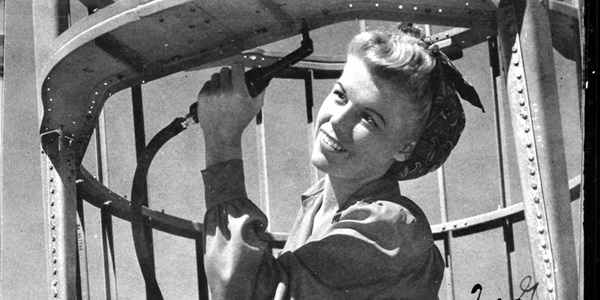Grumman War Production hired its first female employee in 1942.
In His DNA
Chris flew the last F-14 Tomcat back to Northrop Grumman in 2006.

By Leona Donaldson
The plane sputtered, waves of heat rising from the ground below. Listening to the familiar hum of engines and the environmental control system, U.S. Navy Lt. Cmdr. Chris Richard felt the plane choke when the last bit of fuel ran out. The F-14 Tomcat — the “Big Fighter” Chris had flown for nearly a decade — had reached the end of its service life. Furrowing his brows to contain his emotion, Chris hoisted an American flag onto the plane’s nose to honor its service to national security, the Carrier Air Wing and Chris’ own life.
“For those of us who flew the F-14, it becomes part of you,” Chris said. “It wasn’t a plane you just jumped into. When you’re part of the Tomcat community, the plane becomes part of your DNA.”
That October day in 2006 marked the last flight the F-14 would ever take in service to the United States. Chris delivered it back to Northrop Grumman, landing in Long Island, New York, a few miles away from where the F-14 had been manufactured since the 1970s. After Chris climbed down the jet ladder, he walked over to the crowd, which included Northrop Grumman employees and retirees, some who had spent decades working at the company’s Bethpage, New York, facility on the F-14.
“They were the designers, the maintainers, the sustainers that worked for Northrop Grumman,” Chris said. “Their lives — sweat, blood and tears — went into that aircraft.”
Heritage and Loyalty
Soon after that last flight, Chris and his squadron transitioned to flying the F/A-18E Super Hornet. Piloting strike fighters, paired with a variety of assignments — including one as a Weapon School Strike Fighter Tactics instructor after graduating from TOPGUN — rounded out Chris’ military career.
Through it all, the sense of Northrop Grumman employee pride and the company’s enduring commitment to naval aviation Chris witnessed on the Long Island airstrip left a lasting mark. He joined the company after retiring from the Navy as a commander in 2015 to work in business development, with the goal of helping the company continue its legacy of providing advanced warfighting capabilities to the fleet.
“One of the reasons I came to Northrop Grumman was the pride people took in the company and the heritage I felt when I flew the last one home years earlier,” he said. “I got to meet people who met their spouse here —and now their kids work here. The heritage and loyalty people feel for Northrop Grumman is hard to find.”
Chris said his work has also enabled him to sustain a meaningful connection to naval aviation.
“The footprint Northrop Grumman has on an aircraft carrier today stems from our legacy of fighter development,” he said. “It’s so impressive that we build about 50% of the F/A-18 Super Hornet and EA-18G Growler, as well as a significant portion of the F-35 and its advanced mission systems.”
Coupled with the E-2D Advanced Hawkeye's battle management capability, Chris said he feels a strong tie to the Navy and the carrier air wing every day.
.png%3Fh%3D400%26iar%3D0%26w%3D600%26rev%3D16c969b1d1904aa6983ad6cf70c579aa&w=3840&q=100)
A Personal Mission
Recently, Chris has found a new connection with the mission — and with his fellow Northrop Grumman employees whose children have followed in their footsteps.
“My daughter commissioned from the same ROTC unit I was in and graduated from the same university,” said Chris, who graduated from Florida State University and commissioned out of its ROTC program in 1993. “She’s going to Naval Air Station Pensacola to start her pilot training, and my son wants to go into the military, too. I’m working for the company building the airplanes they’ll fly in.”
What employees do now and in the future supports one thing: the mission, said Chris.
“When you’re part of the Northrop Grumman team, the mission becomes part of your DNA,” he said. “The military-industry team has the opportunity to get it right — to give the military the capability it needs, and make sure that kids like mine, who are learning to fly today, come home safely in the future.”
Life at Northrop Grumman
Your work at Northrop Grumman makes a difference. Whether you want to design next-generation aircraft, harness digital technologies or build spacecraft that will return humanity to the moon, you’ll contribute to technology that’s transforming the world. Check out our career opportunities to see how you can help define possible.


